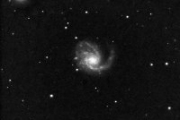Viewings: 4059

In the galaxy m that is in the constellation of Virgo, something strange happens. The telescope "Hubble" recorded some spark, not like a star with variable illumination, nor supernova explosion. "Compromising" galaxy picture was found in the electronic library Amateur astronomer M. Nowak, participant of the contest"Hidden treasures".
The telescope "Hubble" already more than 15 years of productive work in the near-earth space. A tireless worker gave scientists over a million images of celestial objects, the number of which the shots more than 22 thousand! And he, notice, does not prevent the atmosphere. The total amount of information conveyed telescope, is estimated at 50 terabytes, and processing of this information flow is a real Paradise not only for professionals but also for Amateur astronomy.
For those fascinated by astronomy people from all over the world and was given the contest"Hidden Treasures" - "Hidden treasures". Well, open your treasure, and to show his humanity is truly beautiful and worthy lesson! And most importantly, no need to re-watch the sky - in a huge electronic pantry telescope "Hubble" you can search and find one that has not noticed before - something unusual, requiring explanation.
Soon the results of this wonderful contest will be announced. At least, the applications have already been completed. And here is one example of such application is a mysterious picture camera telescope "Hubble"depicting the part of major spiral arms of the galaxy M 99.
This galaxy similar to our milky way - at least in its broad sleeves seen a lot of bright stars. M99 is a typical representative of ordered spiral galaxies. From it we are separated by the distance to 52.7 million light years. Name it has its own history - it refers to the Messier catalogue.
The author of this first catalogue was included in the list of about 100 different objects, the nature of which was subsequently clarified. But in the memory of the compiler of the catalogue of Charles Messier numbered objects it has retained capital letter M and a sequence number in accordance with the directory. Since the Charles Messier was "Fisher comets", then the directory contained objects on the celestial sphere that the astronomer was offered not to be confused with comets.
And, most interestingly, he was right - in modern classification in its catalogue there are six galactic nebulae, 28 scattered star clusters and four planetary nebula, 29 globular clusters, 40 galaxies and three other object. Messier catalogue does not contain Magellanic clouds that can be seen in the southern hemisphere, because of observation took place in the Northern hemisphere, North of 35 degrees South latitude. But it included the Andromeda Galaxy M31 and Triangle m of the local group of galaxies, the crab nebula (M1, outdoor John Bevisa in 1731, the brightest object in the Galaxy M45, visible to the naked eye.
It should be noted that many of the objects of the Messier catalogue were discovered earlier, but the author has also added to this list their discoveries. Some of them are included in the directory even after the death of Charles Messier, they were recorded in the logbooks. And William Herschel, who have a far more perfect telescope, during the lifetime of Messier presented a list of several thousand distant objects included in the new galactic directory in which objects are designated NGC.
Now there are about 2000 of galaxies in the constellation Virgo, 15 of them were included Messier in its directory. Among them m ("NGC 4254), found one of the first in the XVIII century.
So, according to "Hubble", it is something puzzling astronomers, and these unexplained phenomena strongly require interpretation. And if exactly one of the brightest stars in M 99 characterized by a very unusual behavior.
This yellow-orange star PTF 10fqs, located in the upper left corner of the picture was first investigated the Palomar Observatory. Sharp unusual changes the brightness of the stars (or short-term events, in the jargon of astronomers) very puzzled astronomers. They did not match the well-known signs of the variables of light or behavior exploding supernova. It turns out that this variable star was not entered in the accepted classification: it was brighter than the new illumination of the surface of the star, but weaker supernova killed in a powerful explosion of a massive star, generated in a thermonuclear processes Bang the diversity of chemical elements.
There are several explanations, including one outstanding: star PTF 10fqs absorbs near giant planet, and it briefly in astronomical sense event observed variability in the glow of unusual stars. The image shown on the image was obtained in June 2010, at this time, the brightness of the mysterious stars gradually decreased, and the opportunity to establish the location of the PTF 10fqs with high accuracy. It is very important for further observation - even after the star will cease to be the brightest object or even disappears from sight, surveillance weakly glowing object will be continued.
Intriguing picture archive "Hubble" with an unusual star in the arm of the galaxy m in the constellation of Virgo was found by the Offeror "Hidden treasures", the astronomer-Amateur-Matej Novak. And all the professional jury is convinced that this is only the beginning of a whole series of sensations - because the competition was held precisely in order to show how rich the most extensive collection of images containing the germs of discoveries! We need only look good pictures, to see in them something unusual and present their discovery to the General public and specialists.
















